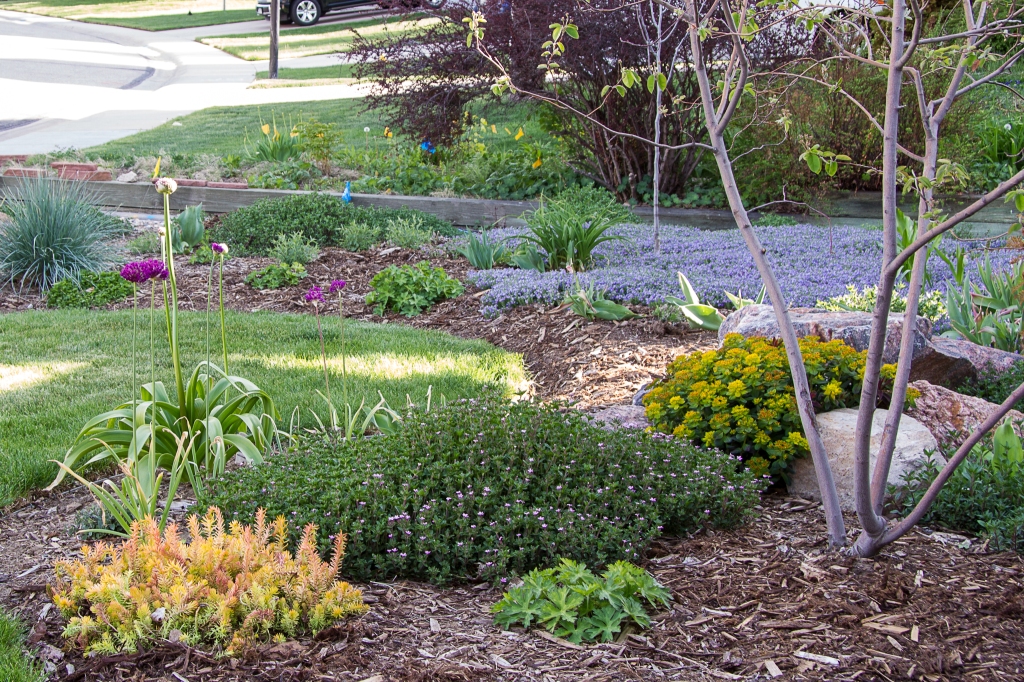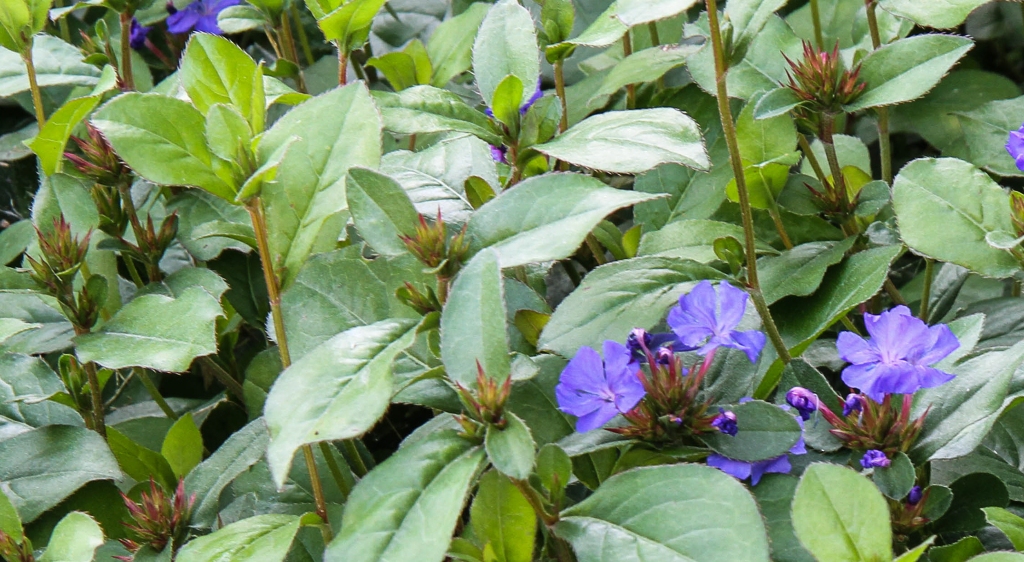
I love brightly colored plants in the garden, such as red fire Meidiland rose, yellow Genista lydia bangle, and neon orange carpet hummingbird mint.
If my garden consisted entirely of these gob-smacking colors, though, the effect would be overwhelming.
That’s why blues are so important. Unlike bright colors which advance toward you, cool blues recede. This receding quality creates depth and provides a calming effect in the landscape.
Blues also add interest because blue plants are much rarer in the garden than other colors of plants. That’s why I’m always on the lookout for them.
Some of my favorite blue flora include:
Veronica pectinata. This low-growing groundcover transforms into a carpet of cornflower blue blossoms the size of a pencil eraser in early spring. The carpet offers the perfect backdrop for vividly colored tulips and white serviceberry trees and shrubs. Other favorite veronicas are V. prostrata (another groundcover) and V. austriaca ‘Crater Lake Blue.’ Crater Lake Blue, which grows about a foot high and wide, produces electric blue blooms. It’s more of a show-stopper than a backdrop.
Siberian squill (Scilla siberica). If you live in places like Wisconsin or Minnesota, avoid this plant because it’s considered invasive. In Colorado, however, Siberian squill behaves itself. It’s a beautiful, delicate-looking bulbous perennial that grows three to six inches high in early spring. Sprinkle it among your miniature daffodil and iris bulbs.

Hardy plumbago (Ceratostigma plumbaginoides). This stalwart groundcover produces stunning azure blue blooms with contrasting copper-colored seedheads in July. The first time I saw a photo of this plant, I thought the blooms couldn’t possibly be this gorgeous in person. But they are. It’ll grow in both sun and shade, but prefers shade from afternoon sun. Plumbago grows six to eight inches high and 18 inches or more wide.
Blue avena grass (Helictotrichon sempervirens). Also called blue oat grass, this graceful, arching grass grows two to three feet high and wide. With its steel blue leaves, this grass blends well with just about anything in the garden. In June, it sends up tawny flowering spikes. In the fall, the grass becomes wheat-colored, providing interest throughout the fall and winter. Cut blue avena down to the ground in early spring so new growth can emerge.

Electric blue penstemon (Penstemon heterphyllus ‘Electric Blue’). Electric blue describes this bloomer perfectly. The plant produces a profusion of intensely blue blooms in June, and it lasts several weeks. Electric blue grows about 15 to 18 inches high and 12 inches wide. Deadhead it when it’s done blooming.
Narbonne blue flax (Linum narbonense). There are several species of blue flax. Narbonne, introduced by Plant Select in 2013, performs pretty well in my amended clay soil even though it’s supposed to prefer sandy or loam soil. Photos often make the blooms look purple, but mine are intensely blue. Narbonne grows 16 to 18 inches high and wide.
Other blue plants worth mentioning are:
Hostas. These broad-leaved plants come in an array of colors. Blue varieties include June, blue Hawaii, fragrant blue, blue heaven, and many more.
Irises. The American Iris Society offers remarkable photos of blue varieties, such as babbling brook, Baltic Sea, cloud ballet, and color me blue.
Rocky Mountain Columbine (Aquilegia coerulea or A. caerulea). This iconic treasure is the state flower of Colorado. It’s a short-lived perennial that reseeds prolifically and grows one to two feet high and wide.
Delphiniums. These upright, architectural plants generate cobalt blue blooms. Be aware, though, that annual dephiniums, or larkspur, reseed like crazy. It’s possible to have too much of a good thing.
Morning glories. Be prepared for aggressive reseeding if you plant morning glories. But if you have room for them, they’ll reward you with heavenly deep blue flowers.
So there you have it—lots of choices for adding blue to your garden. I encourage to try some if you haven’t already.
